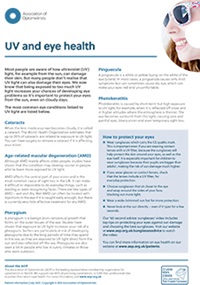UV and eye health
The eye conditions linked to UV light and how to protect your eyes
Most people are aware of how ultraviolet (UV) light, for example from the sun, can damage their skin. But many people don’t realise that UV light can also damage their eyes. We now know that being exposed to too much UV light increases your chances of developing eye problems so it’s important to protect your eyes from the sun, even on cloudy days.
The most common eye conditions linked to UV light are listed below.
Cataracts
When the lens inside your eye becomes cloudy, it is called a cataract. The World Health Organization estimates that up to 20% of cataracts are related to exposure to UV light. You can have surgery to remove a cataract if it is affecting your vision.
Age-related macular degeneration (AMD)
Although AMD mainly affects older people, studies have shown that this condition may develop sooner in people who’ve been more exposed to UV light.
AMD affects the central part of your vision and is the most common cause of sight loss in the UK. It can make it difficult or impossible to do everyday things, such as reading or even recognising faces. There are two types of AMD – wet and dry. Wet AMD can often be treated with injections in the eye if it is caught early enough, but there is currently very little effective treatment for dry AMD.
Pterygium
A pterygium is a benign (non-cancerous) growth that forms on the outer tissues of the eye. Studies have shown that exposure to UV light increases your risk of a pterygium. Surfers are particularly at risk of developing pterygiums due to the long periods of time they spend in the sea, as they are exposed to UV light direct from the sun and also reflected off the sea. Pterygiums are also seen a lot in people who live in sunny climates or those who work outdoors.
Pinguecula
A pinguecula is a white or yellow bump on the white of the eye (sclera). In most cases, a pinguecula causes only mild symptoms but can sometimes cause dry eye, which can make your eyes red and uncomfortable.
Photokeratitis
Photokeratitis is caused by short-term but high exposure to UV light, for example, when it is reflected off snow and in higher altitudes where the atmosphere is thinner. The eye becomes sunburnt from this light, causing sore and painful eyes, blurry vision and even temporary sight loss.
How to protect your eyes
- Wear sunglasses which carry the CE quality mark. This is important even if you are wearing contact lenses with a UV filter, because the sunglasses will help protect the skin around your eyes, as well as the eye itself. It is especially important for children to wear sunglasses because their pupils are bigger than adults’, making the risk of sun damage much higher
- If you wear glasses or contact lenses, check that the lenses include a UV filter, for everyday protection
- Choose sunglasses that sit closer to the eye and wrap around the sides of your face, blocking out more light
- Wear a wide-brimmed sun hat for more protection
- Never look at the sun directly – even if it’s just for a few seconds
Our 60 second advice: sunglasses video includes top tips on protecting your eyes against sun damage and choosing the best sunglasses.
Resources for your practice
Download our patient leaflet on UV and eye health. 

